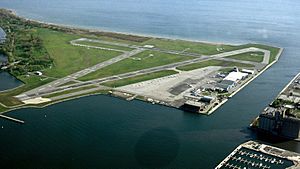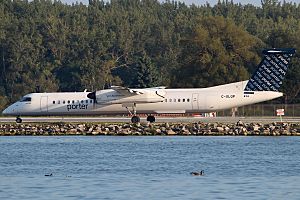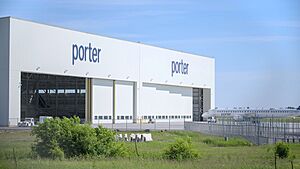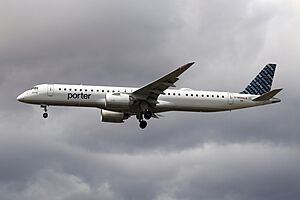Porter Airlines facts for kids

An Embraer E195-E2 of Porter Airlines
|
|
| Founded | February 2, 2006 |
|---|---|
| Commenced operations | October 23, 2006 |
| AOC # |
|
| Hubs |
|
| Focus cities |
|
| Frequent-flyer program | VIPorter |
| Fleet size | 76 |
| Destinations | 32 |
| Parent company | Porter Aviation Holdings Inc. |
| Headquarters | Billy Bishop Toronto City Airport, Toronto, Ontario, Canada |
| Key people | |
Porter Airlines is a Canadian airline based in Toronto. It is the third largest airline in Canada. Porter Airlines flies from its main bases in Eastern Canada. These include Ottawa, Toronto–Billy Bishop, and Toronto–Pearson.
Porter Airlines uses two types of planes. They fly De Havilland Canada DHC-8-400 turboprop planes. They also use Embraer 195-E2 jet aircraft. These planes take passengers to many places across North America.
The airline started flying from Toronto City Airport in 2006. This airport is on an island near downtown Toronto. Robert Deluce, who is now the Executive Chairman of Porter Airlines, wanted to create a new airline. He planned to use turboprop planes to fly to major Canadian cities.
A bridge to the airport was planned but then cancelled in 2003. This led to some disagreements. Porter Airlines later bought the airport terminal that another airline, Air Canada Jazz, used. Porter then expanded its flights and added more destinations and planes. In 2010, Porter opened a new, larger terminal at the island airport. A special tunnel connecting the airport to the mainland opened in 2015.
In 2013, Porter wanted to expand the Toronto Island airport to allow jet planes. The city council did not fully support this idea. In 2015, the Canadian government decided not to allow the jet expansion.
In March 2020, Porter stopped all flights because of the COVID-19 pandemic. Flights started again in September 2021, after about 18 months. Porter Airlines received loans from the Canadian government to help them recover.
In July 2021, Porter announced new plans. They started flying from Toronto Pearson International Airport in 2022. This allowed them to fly to more places in Canada, the United States, and the Caribbean. They also expanded their flights from Ottawa's Macdonald–Cartier International Airport. Ottawa is now a key hub where both types of Porter's planes fly regularly. Porter's biggest plane maintenance building is also in Ottawa.
Contents
How Porter Airlines Works
Porter Airlines is part of a bigger company called Porter Aviation Holdings (PAHL). This company also owns Porter FBO Limited, which manages the airport facilities at Billy Bishop. Another part, City Centre Terminal Corp., manages Porter's terminal. The Deluce family, including Robert Deluce and his son Michael, control Porter Aviation Holdings.
- Key Leaders
- Robert Deluce is the Executive Chairman of Porter Airlines.
- Michael Deluce, Robert's son, is the Chief Executive Officer (CEO).
- Kevin Jackson is the President of Porter Airlines.
Porter Aviation Holdings bought the Toronto island airport buildings in 2005. They then renovated the terminal for Porter Airlines. Porter FBO now runs the terminal and provides services like fuel. In 2009, a new company, City Centre Terminal Corp., was created to manage Porter's new terminal. This new terminal opened in phases, starting in March 2010. It has ten gates, lounges, and food places.
The airline's fun character is a raccoon named "Mr. Porter." You can see him in their ads. Porter also uses radio ads and has staff uniforms inspired by 1960s airline styles.
In January 2015, Porter sold the terminal at the island airport. This helped the airline become debt-free. They now pay to use the terminal.
Porter Airlines Story

The start of Porter Airlines was a bit tricky. Some people in Toronto wanted to close the airport or stop it from growing. Others, including businesses, wanted the airport to be more active. Before Porter, only Air Canada's Jazz service flew from the island airport.
In 2002, the Toronto Port Authority (TPA) planned to improve the airport. They wanted to build a bridge and a new terminal. Robert Deluce planned to start a new airline there. The City of Toronto approved these plans in 2002.
However, local residents and groups like Community Air opposed the bridge. In 2003, a new mayor, David Miller, was elected. He and the city council voted to cancel the bridge project.
After the bridge was cancelled, Robert Deluce's company bought the airport building that Jazz was using. They ended Jazz's lease. On February 2, 2006, Deluce announced Porter Airlines would start flying. The first flights were planned for October 2006, starting with a route from Toronto to Ottawa.
The TPA also improved ferry service to the island airport for the new airline. But some people were worried about more noise and air pollution from the planes.
Safety was also a concern. The airport's main runway is shorter than what some planes usually need. Porter solved this by fitting their planes for 70 passengers, which is less than the maximum. This allows them to use the shorter runway safely. Pilots also have special instructions for flying into the airport because of nearby buildings and other things.
Porter's first flight was on October 23, 2006, to Ottawa. At first, some people protested at the ferry dock. They asked passengers not to use the new service. The protests eventually stopped.
The TPA and Porter continued to work together to expand the airport. In 2009, Porter announced plans to build a new $45 million terminal at the island airport. This new terminal would have Canadian Customs, restaurants, and more space. The first part of the new terminal opened in March 2010.
Porter has sometimes landed planes after the airport's 11 p.m. curfew. When this happened, they were fined.
From 2010 to 2012, Porter worked with plane makers to test special fuels. They even flew a plane from Toronto to Ottawa using a mix of biofuel and jet fuel. This was a first for a commercial flight in Canada.
In 2014, another airport in Montreal, Montréal/Saint-Hubert Airport, wanted Porter to fly there. Porter said a new terminal would be needed for that to happen.
Expanding with Jets at Pearson and Ottawa
In 2021, Porter ordered 30 new Embraer 195-E2 jet planes. They later increased this order to 50 jets. Since jets are not allowed at Toronto Island Airport, Porter started flying these new jets from Toronto Pearson International Airport. This allowed them to fly to new places in Western Canada, like Vancouver, Edmonton, and Calgary. They also added more flights to existing places in Eastern Canada, like Ottawa, Montreal, and Halifax.
Porter also started new routes from Ottawa. These include flights to cities in the eastern United States, like New York-Newark and Boston. They also added Canadian cities like Charlottetown and Thunder Bay from Ottawa. In November 2023, Porter ordered another 25 jets, bringing their total firm orders to 75.
Porter is building a new terminal at the MET – Montreal Metropolitan Airport (formerly Montréal Saint-Hubert - Longueuil Airport). This terminal is expected to be finished by the end of 2025. It will create many new jobs. Porter will fly both its turboprop and jet planes from this airport.
Porter has also built a new maintenance base at Ottawa Macdonald–Cartier International Airport. This large building is where Porter's Embraer 195-E2 jets are maintained. Porter works with Algonquin College to offer learning opportunities at this facility.
Where Porter Airlines Flies
Main Hubs
Porter Airlines has three main hubs, which are like their home bases:
- Toronto–Billy Bishop: This is Porter's hub for shorter flights from downtown Toronto. They fly to places in Ontario, Quebec, Atlantic Canada, and some cities in the United States. Porter's De Havilland Canada Dash 8-400 planes are based here.
- Toronto–Pearson: This is Porter's main hub for connecting Toronto to places across North America. Porter's Embraer 195-E2 jet planes are based here.
- Ottawa Macdonald-Cartier: This is Porter's second main hub. It connects Ottawa to places across North America. It is also the main place for maintaining Porter's Embraer 195-E2 planes.
Destinations
As of August 2025, Porter Airlines flies to many places. Here are some of them:
| Country | Province / State | City | Airport | Notes | Refs |
|---|---|---|---|---|---|
| Bahamas | Nassau | Lynden Pindling International Airport | Begins December 13, 2025 | ||
| Canada | Alberta | Calgary | Calgary International Airport | ||
| Edmonton | Edmonton International Airport | ||||
| British Columbia | Kelowna | Kelowna International Airport | |||
| Vancouver | Vancouver International Airport | ||||
| Victoria | Victoria International Airport | ||||
| Manitoba | Winnipeg | Winnipeg James Armstrong Richardson International Airport | |||
| New Brunswick | Fredericton | Fredericton International Airport | |||
| Moncton | Greater Moncton Roméo LeBlanc International Airport | ||||
| Newfoundland and Labrador | Deer Lake | Deer Lake Regional Airport | Seasonal | ||
| Stephenville | Stephenville International Airport | Terminated | |||
| St. John's | St. John's International Airport | ||||
| Nova Scotia | Halifax | Halifax Stanfield International Airport | Focus city | ||
| Ontario | Hamilton | John C. Munro Hamilton International Airport | Focus city | ||
| Muskoka | Muskoka Airport | Terminated | |||
| North Bay | North Bay/Jack Garland Airport | Terminated | |||
| Ottawa | Ottawa Macdonald–Cartier International Airport | Hub | |||
| Sault Ste. Marie | Sault Ste. Marie Airport | ||||
| Sudbury | Sudbury Airport | ||||
| Timmins | Timmins/Victor M. Power Airport | ||||
| Thunder Bay | Thunder Bay International Airport | ||||
| Toronto | Billy Bishop Toronto City Airport | Hub | |||
| Toronto Pearson International Airport | Hub | ||||
| Windsor | Windsor International Airport | ||||
| Prince Edward Island | Charlottetown | Charlottetown Airport | |||
| Quebec | Montreal | Montréal–Trudeau International Airport | Focus city | ||
| Mont-Tremblant | Mont-Tremblant International Airport | Terminated | |||
| Quebec City | Québec City Jean Lesage International Airport | ||||
| Saskatchewan | Saskatoon | Saskatoon John G. Diefenbaker International Airport | |||
| Cayman Islands | George Town | Owen Roberts International Airport | Begins December 16, 2025 | ||
| Costa Rica | Guanacaste | Liberia | Guanacaste Airport | Begins December 4, 2025 | |
| Mexico | Jalisco | Puerto Vallarta | Licenciado Gustavo Díaz Ordaz International Airport | Begins November 14, 2025 | |
| Quintana Roo | Cancún | Cancún International Airport | Begins November 5, 2025 | ||
| United States | Arizona | Phoenix | Phoenix Sky Harbor International Airport | ||
| California | Los Angeles | Los Angeles International Airport | |||
| Palm Springs | Palm Springs International Airport | Seasonal | |||
| San Diego | San Diego International Airport | Terminated | |||
| San Francisco | San Francisco International Airport | ||||
| District of Columbia/Virginia | Washington, D.C. | Dulles International Airport | |||
| Florida | Fort Lauderdale | Fort Lauderdale–Hollywood International Airport | |||
| Fort Myers | Southwest Florida International Airport | Seasonal | |||
| Melbourne | Melbourne Orlando International Airport | Terminated | |||
| Miami | Miami International Airport | Seasonal | |||
| Orlando | Orlando International Airport | ||||
| Tampa | Tampa International Airport | Seasonal | |||
| West Palm Beach | Palm Beach International Airport | Seasonal | |||
| Illinois | Chicago | Midway International Airport | |||
| Massachusetts | Boston | Logan International Airport | |||
| Nevada | Las Vegas | Harry Reid International Airport | |||
| South Carolina | Charleston | Charleston International Airport | Terminated | ||
| Myrtle Beach | Myrtle Beach International Airport | Terminated | |||
| New Jersey | Newark | Newark Liberty International Airport | |||
| New York | New York City | LaGuardia Airport | |||
| Pennsylvania | Pittsburgh | Pittsburgh International Airport | Terminated | ||
| Vermont | Burlington | Patrick Leahy Burlington International Airport | Terminated |
Airline Partnerships
Porter works with other airlines to make travel easier.
- Codeshare agreements: Porter shares flights with Air Transat. This means you can book a flight with one airline, but fly on a plane operated by the other.
- Interline agreements: Porter has agreements with many airlines. This allows passengers to book flights with different airlines on one ticket. For example, you could fly with Porter and then connect to a flight with British Airways or Delta Air Lines.
Porter Airlines Fleet
As of August 2025, Porter Airlines uses these planes:
| Aircraft | In service | Orders | Passengers | Refs | Notes | |||
|---|---|---|---|---|---|---|---|---|
| W | Y+ | Y | Total | |||||
| De Havilland Canada Dash 8-400 | 29 | — | 6 | — | 72 | 78 | ||
| Embraer E195-E2 | 47 | 28 | 16 | 20 | 96 | 132 | Purchase rights for an additional 25 aircraft. | |
| Total | 76 | 28 | ||||||
Porter first ordered ten Bombardier Q400 turboprop planes. They later added more. These planes were set up to hold 70 passengers. This was because the runway at Toronto Island Airport is shorter. In 2021, Porter updated the inside of their Q400 planes. They added more seats, so now each plane can hold 78 passengers.
In July 2021, Porter announced they would buy 30 Embraer 195-E2 jet planes. They also had the option to buy 50 more. Since jets cannot fly from Billy Bishop Toronto City Airport, these planes are based at Toronto Pearson and Ottawa airports. They also fly from Montreal and Halifax. These new jets help Porter fly to more places in Canada, the United States, Mexico, and the Caribbean. Porter started receiving these new jets in December 2022.
What Porter Offers
Cabin Classes
Porter offers different ways to fly:
- PorterReserve: This is their premium option. It's available on both Dash 8-400 and E195-E2 planes. These seats have more legroom. Passengers get free beer, wine, and bigger snacks. On longer flights (over 2.5 hours) with the E195-E2, PorterReserve passengers also get a free meal.
- PorterClassic Stretch: This is only on the E195-E2 jets. These seats also have extra legroom.
- PorterClassic: This is the standard seating on both types of planes.
Onboard Fun
Porter gives free snacks and drinks to all passengers. This includes free beer and wine. All drinks are served in real glassware. On E195-E2 flights longer than 150 minutes, fresh food is also offered.
Porter's planes do not have screens on the back of the seats for entertainment. However, they offer free Wi-Fi on their E195-E2 jet planes.
Extra Services
Porter has a rewards program called 'VIPorter'. You can earn points and use them for free flights. They also offer a free shuttle bus between Toronto's Union Station and Billy Bishop Toronto City Airport. The bus leaves every 15 minutes.
See also
 In Spanish: Porter Airlines para niños
In Spanish: Porter Airlines para niños





